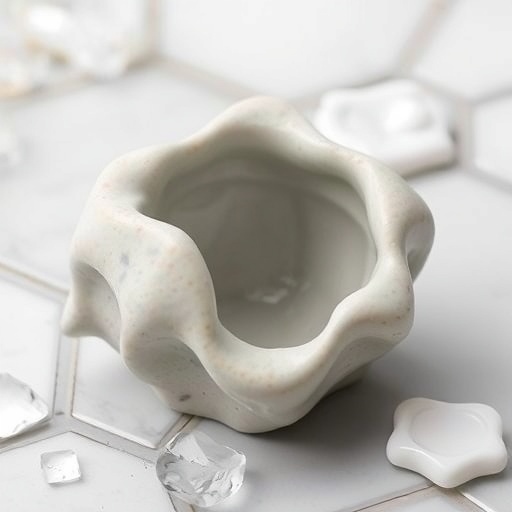Recent advances in material science have unveiled exciting insights into the properties of advanced ceramics, particularly concerning their phase structure, AC conductivity, and thermistor performance. A groundbreaking study led by Agnihotri et al. has explored these properties in detail for the composite material comprised of 0.70Na₀.₅Bi₀.₅TiO₃–0.30BaMn₀.₅Ti₀.₅O₃. This specific combination of materials has shown promising performance in various electronic applications, marking a significant leap forward in the pursuit of more efficient and effective ceramic materials.
In this exhaustive investigation, the researchers examined the phase structure of the Na₀.₅Bi₀.₅TiO₃ and BaMn₀.₅Ti₀.₅O₃ ceramics, which are integral to developing electronic devices with high functionality. By utilizing X-ray diffraction and scanning electron microscopy, the team was able to observe the crystallographic changes that occur in the ceramic materials when subjected to different environmental conditions. This analysis is crucial as the phase structure often dictates the electrical, thermal, and mechanical properties of ceramic materials, influencing their suitability for practical applications.
Moreover, the study delves into the AC conductivity of the evaluated ceramics. Understanding AC conductivity plays a pivotal role in the development of materials used in capacitor technology, where efficiency and reliability are paramount. The researchers employed an array of electrical characterization techniques, including impedance spectroscopy, to quantify conductivity variations across a spectrum of frequencies and temperatures. The findings indicated that the AC conductivity of the prepared ceramics significantly improved, suggesting a potential for their application in high-frequency devices where traditional materials may falter.
.adsslot_QPiR4gEGfK{width:728px !important;height:90px !important;}
@media(max-width:1199px){ .adsslot_QPiR4gEGfK{width:468px !important;height:60px !important;}
}
@media(max-width:767px){ .adsslot_QPiR4gEGfK{width:320px !important;height:50px !important;}
}
ADVERTISEMENT
In addition to phase structure and conductivity, Agnihotri and colleagues thoroughly assessed the thermistor performance of these ceramics. Thermistors are resistive temperature devices that can effectively measure and control temperature variations. By adjusting the ratios of Na₀.₅Bi₀.₅TiO₃ and BaMn₀.₅Ti₀.₅O₃, the researchers aimed to enhance the thermistor’s sensitivity and temperature coefficient. The results indicated that the newly developed ceramics exhibited favorable thermistor characteristics, positioning them as strong candidates for temperature-sensing applications in the automotive and consumer electronics sectors.
The implications of this research are vast, considering the current demand for advanced electronic components that exhibit both reliability and accuracy. The transition to materials such as 0.70Na₀.₅Bi₀.₅TiO₃–0.30BaMn₀.₅Ti₀.₅O₃ not only paves the way for innovative designs but also aligns with global trends toward sustainable and efficient material usage. The enhanced material performance depicted in the study could lead to reduced energy consumption in electronic devices, thereby contributing to environmental sustainability.
In examining the mechanical properties of the ceramic composites, the researchers conducted several tests to evaluate their toughness, flexural strength, and thermal stability. These attributes are particularly critical in applications where the ceramics may be subjected to extreme thermal and mechanical stress. The assessment indicated that the material maintained its integrity under various conditions, suggesting that it could fulfill demanding requirements in high-performance applications.
The potential for commercialization of these materials presents an exciting opportunity for industries that rely heavily on thermistors and capacitors. With the rise of Internet of Things (IoT) devices and smart technology, demand for efficient and accurate sensing devices is at an all-time high. This research provides a clearer pathway for manufacturers to incorporate these new ceramic materials into their product lines, ultimately enhancing device capabilities and performance.
In the realm of future research, the paper opens avenues for further exploration. Investigations into the long-term stability and reliability of these ceramic materials under real-world conditions will be essential to verify their practical applicability. Additionally, further optimization of the material composition could lead to even greater advancements in phase structure and conductivity, solidifying their place in the forefront of materials science.
The impact of advancements in ceramic technology reaches beyond electronics; they hold potential in sectors such as renewable energy and biomedical applications. The conduction and sensing properties of these materials may facilitate developments in energy harvesting and smart medical devices. Overall, the extensive exploration conducted by Agnihotri et al. contributes significantly to the field, spotlighting a promising path for future innovations.
In summary, the comprehensive study on the 0.70Na₀.₅Bi₀.₅TiO₃–0.30BaMn₀.₅Ti₀.₅O₃ ceramics demonstrates the intricate relationship between composition, phase structure, and electrical properties. The resolution of key challenges in conductivity and thermistor performance not only signifies a leap in material science but also suggests transformative potential across multiple technological domains. This investigation serves as a critical touchpoint for researchers and industry professionals alike, advocating for continued exploration and application in advanced ceramic materials.
The future of material science is bright as researchers like Agnihotri and colleagues push the boundaries of what is possible with ceramics. As we delve deeper into the potential of these composites, we can expect to see an exciting interplay between scientific ingenuity and practical application, yielding robust solutions for tomorrow’s technological challenges.
In conclusion, the findings presented in this research underscore the importance of continuously evolving our understanding of material properties and their implications within a technological context. As we harness these innovations, we draw closer to realizing the full potential of advanced materials in shaping a more efficient, sustainable future.
Subject of Research: Advanced ceramics in electronic applications
Article Title: Phase structure, AC conductivity, and thermistor performance in 0.70Na₀.₅Bi₀.₅TiO₃–0.30BaMn₀.₅Ti₀.₅O₃ ceramics.
Article References: Agnihotri, P., Goel, R., Priyanka et al. Phase structure, AC conductivity, and thermistor performance in 0.70Na₀.₅Bi₀.₅TiO₃–0.30BaMn₀.₅Ti₀.₅O₃ ceramics. Ionics (2025). https://doi.org/10.1007/s11581-025-06528-2
Image Credits: AI Generated
DOI: https://doi.org/10.1007/s11581-025-06528-2
Keywords: Advanced ceramics, AC conductivity, thermistor performance, Na₀.₅Bi₀.₅TiO₃, BaMn₀.₅Ti₀.₅O₃.
Tags: AC conductivity in ceramic materialsadvanced ceramics propertiesBaMn₀.₅Ti₀.₅O₃ electrical propertiesceramic materials in capacitor technologyefficient electronic materials developmentenvironmental effects on ceramic phase structureimpedance spectroscopy for conductivity measurementNa₀.₅Bi₀.₅TiO₃ material applicationsphase structure analysis in ceramicsscanning electron microscopy in ceramicsthermistor performance in electronicsX-ray diffraction in material science





